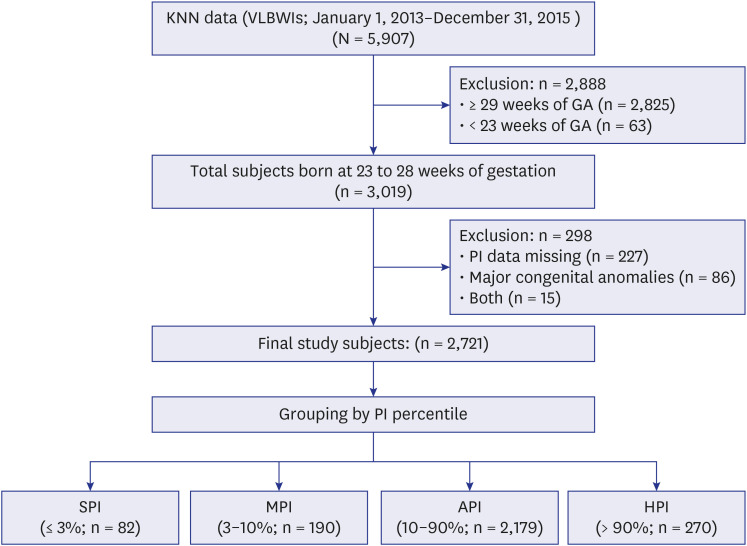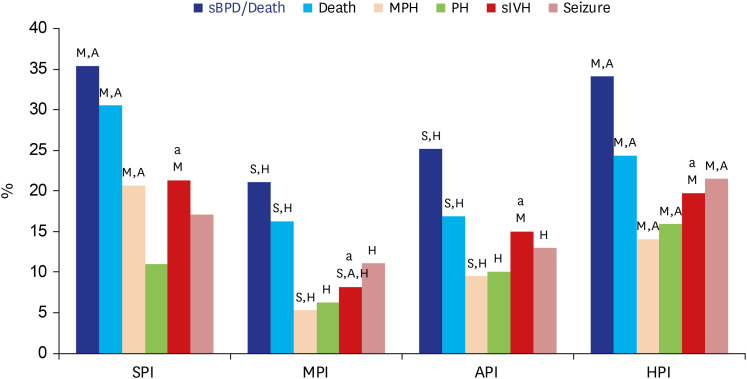J Korean Med Sci.
2022 Jun;37(24):e198. 10.3346/jkms.2022.37.e198.
Effects of Ponderal Index on Neonatal Mortality and Morbidities in Extremely Premature Infants
- Affiliations
-
- 1Department of Pediatrics, Hanyang University Guri Hospital, Guri, Korea
- 2Department of Pediatrics, Cheongju St. Mary’s Hospital, Cheongju, Korea
- 3Department of Pediatrics, Hanyang University Seoul Hospital, Seoul, Korea
- 4Department of Pediatrics, College of Medicine, Hanyang University, Seoul, Korea
- KMID: 2530509
- DOI: http://doi.org/10.3346/jkms.2022.37.e198
Abstract
- Background
To evaluate how intrauterine stress affects extremely premature infants in terms of intrauterine growth restriction. We hypothesized that extremely premature infants with mildly-low ponderal index (MPI) would have better neonatal outcomes.
Methods
We selected 2,721 subjects of 23 to 28 weeks of gestation between 2013 and 2015 from Korean Neonatal Network database. They were divided into 4 groups based on ponderal index (PI) percentile; PI ≤ 3rd as severely-low PI (SPI, n = 82), 3rd < PI ≤ 10th as MPI (n = 190), 10th < PI ≤ 90th as adequate PI (API, n = 2,179), and PI > 90th as high PI (HPI, n = 270).
Results
The mortality in MPI and API groups was comparable (16.3% vs. 16.9%). It was significantly lower than that in the SPI and HPI groups (30.5% and 24.9%, respectively; P = 0.001). The MPI and API groups had better neonatal morbidities compared with the SPI and/or HPI groups, while the MPI group (8.2%) showed a lower incidence of severe intraventricular hemorrhage (IVH) than the other groups (SPI, 21.3%; API, 15.0%; HPI, 19.7%, respectively; P = 0.004). The MPI group had a trend of a bottom in neonatal mortality and morbidities in extremely premature infants.
Conclusion
The MPI and API groups had lower mortality, massive pulmonary hemorrhage, severe bronchopulmonary dysplasia or death, pulmonary hypertension and neonatal seizure rates than the SPI and/or HPI groups, while the MPI group showed a lower incidence of severe IVH than the other groups. We speculate that the lower incidence of neonatal morbidities and mortality in the MPI group indicating mild intrauterine stress might accelerate fetal maturation resulting in better outcomes in extremely premature infants.
Keyword
Figure
Reference
-
1. Nesse RM. Natural selection, mental modules and intelligence. Novartis Found Symp. 2000; 233:96–104. PMID: 11276912.
Article2. Gortner L, Reiss I, Hilgendorff A. Bronchopulmonary dysplasia and intrauterine growth restriction. Lancet. 2006; 368(9529):28.
Article3. Lubchenco LO, Searls DT, Brazie JV. Neonatal mortality rate: relationship to birth weight and gestational age. J Pediatr. 1972; 81(4):814–822. PMID: 5074362.
Article4. Cardwell MS. Stress: pregnancy considerations. Obstet Gynecol Surv. 2013; 68(2):119–129. PMID: 23417218.5. Barker DJ. In utero programming of chronic disease. Clin Sci (Lond). 1998; 95(2):115–128. PMID: 9680492.
Article6. Economides DL, Nicolaides KH, Linton EA, Perry LA, Chard T. Plasma cortisol and adrenocorticotropin in appropriate and small for gestational age fetuses. Fetal Ther. 1988; 3(3):158–164. PMID: 2855870.
Article7. Fowden AL. Endocrine regulation of fetal growth. Reprod Fertil Dev. 1995; 7(3):351–363. PMID: 8606944.
Article8. Westgren M, Lingman G, Persson B. Cordocentesis in IUGR fetuses. Clin Obstet Gynecol. 1997; 40(4):755–763. PMID: 9429790.
Article9. Stewart PM, Rogerson FM, Mason JI. Type 2 11 beta-hydroxysteroid dehydrogenase messenger ribonucleic acid and activity in human placenta and fetal membranes: its relationship to birth weight and putative role in fetal adrenal steroidogenesis. J Clin Endocrinol Metab. 1995; 80(3):885–890. PMID: 7883847.
Article10. Reynolds RM, Labad J, Strachan MW, Braun A, Fowkes FG, Lee AJ, et al. Elevated fasting plasma cortisol is associated with ischemic heart disease and its risk factors in people with type 2 diabetes: the Edinburgh type 2 diabetes study. J Clin Endocrinol Metab. 2010; 95(4):1602–1608. PMID: 20130072.
Article11. Bakketeig LS. Current growth standards, definitions, diagnosis and classification of fetal growth retardation. Eur J Clin Nutr. 1998; 52(Suppl 1):S1–S4.12. Landmann E, Reiss I, Misselwitz B, Gortner L. Ponderal index for discrimination between symmetric and asymmetric growth restriction: percentiles for neonates from 30 weeks to 43 weeks of gestation. J Matern Fetal Neonatal Med. 2006; 19(3):157–160. PMID: 16690508.
Article13. Chard T, Costeloe K, Leaf A. Evidence of growth retardation in neonates of apparently normal weight. Eur J Obstet Gynecol Reprod Biol. 1992; 45(1):59–62. PMID: 1618362.
Article14. Fay RA, Dey PL, Saadie CM, Buhl JA, Gebski VJ. Ponderal index: a better definition of the ‘at risk’ group with intrauterine growth problems than birth-weight for gestational age in term infants. Aust N Z J Obstet Gynaecol. 1991; 31(1):17–19. PMID: 1872765.
Article15. Patterson RM, Pouliot MR. Neonatal morphometrics and perinatal outcome: who is growth retarded? Am J Obstet Gynecol. 1987; 157(3):691–693. PMID: 3509974.
Article16. Vik T, Markestad T, Ahlsten G, Gebre-Medhin M, Jacobsen G, Hoffman HJ, et al. Body proportions and early neonatal morbidity in small-for-gestational-age infants of successive births. Acta Obstet Gynecol Scand Suppl. 1997; 165:76–81. PMID: 9219462.17. Suhag A, Berghella V. Intrauterine growth restriction (IUGR): etiology and diagnosis. Curr Obstet Gynecol Rep. 2013; 2(2):102–111.
Article18. Sharma D, Farahbakhsh N, Shastri S, Sharma P. Intrauterine growth restriction - part 2. J Matern Fetal Neonatal Med. 2016; 29(24):4037–4048. PMID: 26979578.
Article19. Sharma D, Shastri S, Farahbakhsh N, Sharma P. Intrauterine growth restriction - part 1. J Matern Fetal Neonatal Med. 2016; 29(24):3977–3987. PMID: 26856409.
Article20. Sharma D, Shastri S, Sharma P. Intrauterine growth restriction: antenatal and postnatal aspects. Clin Med Insights Pediatr. 2016; 10:67–83. PMID: 27441006.
Article21. Ishimoto H, Jaffe RB. Development and function of the human fetal adrenal cortex: a key component in the feto-placental unit. Endocr Rev. 2011; 32(3):317–355. PMID: 21051591.
Article22. Barker DJ. In utero programming of cardiovascular disease. Theriogenology. 2000; 53(2):555–574. PMID: 10735050.
Article23. Kohno H, Furuhashi N, Fukaya T, Shinkawa O, Tachibana Y, Suzuki M. Serum cortisol levels in maternal venous, umbilical arterial and umbilical venous blood at delivery in the cases of fetal distress. Tohoku J Exp Med. 1984; 144(3):299–304. PMID: 6523499.
Article24. Chang YS, Park HY, Park WS. The Korean Neonatal Network: an overview. J Korean Med Sci. 2015; 30:Suppl 1. (Suppl 1):S3–11. PMID: 26566355.
Article25. Lubchenco LO, Hansman C, Boyd E. Intrauterine growth in length and head circumference as estimated from live births at gestational ages from 26 to 42 weeks. Pediatrics. 1966; 37(3):403–408. PMID: 5906365.
Article26. Papile LA, Burstein J, Burstein R, Koffler H. Incidence and evolution of subependymal and intraventricular hemorrhage: a study of infants with birth weights less than 1,500 gm. J Pediatr. 1978; 92(4):529–534. PMID: 305471.
Article27. Gordon PV, Swanson JR, Attridge JT, Clark R. Emerging trends in acquired neonatal intestinal disease: Is it time to abandon Bell’s criteria? J Perinatol. 2007; 27(11):661–671. PMID: 17611610.
Article28. International Committee for the Classification of Retinopathy of Prematurity. The International Classification of Retinopathy of Prematurity revisited. Arch Ophthalmol. 2005; 123(7):991–999. PMID: 16009843.29. Jobe AH, Bancalari E. Bronchopulmonary dysplasia. Am J Respir Crit Care Med. 2001; 163(7):1723–1729. PMID: 11401896.
Article30. Lim JS, Lim SW, Ahn JH, Song BS, Shim KS, Hwang IT. New Korean reference for birth weight by gestational age and sex: data from the Korean Statistical Information Service (2008-2012). Ann Pediatr Endocrinol Metab. 2014; 19(3):146–153. PMID: 25346919.
Article31. McIntire DD, Bloom SL, Casey BM, Leveno KJ. Birth weight in relation to morbidity and mortality among newborn infants. N Engl J Med. 1999; 340(16):1234–1238. PMID: 10210706.
Article32. Verkauskiene R, Beltrand J, Claris O, Chevenne D, Deghmoun S, Dorgeret S, et al. Impact of fetal growth restriction on body composition and hormonal status at birth in infants of small and appropriate weight for gestational age. Eur J Endocrinol. 2007; 157(5):605–612. PMID: 17984240.
Article33. Faraci M, Renda E, Monte S, Di Prima FA, Valenti O, De Domenico R, et al. Fetal growth restriction: current perspectives. J Prenat Med. 2011; 5(2):31–33. PMID: 22439073.34. Wilcox AJ. Intrauterine growth retardation: beyond birthweight criteria. Early Hum Dev. 1983; 8(3-4):189–193. PMID: 6641564.
Article35. Cooley SM, Donnelly JC, Walsh T, Kirkham C, Gillan J, Geary MP. Ponderal index (PI) vs birth weight centiles in the low-risk primigravid population: Which is the better predictor of fetal wellbeing? J Obstet Gynaecol. 2012; 32(5):439–443. PMID: 22663314.
Article36. Miller HC, Hassanein K. Diagnosis of impaired fetal growth in newborn infants. Pediatrics. 1971; 48(4):511–522. PMID: 5114738.
Article37. Fernández-Alba JJ, González-Macías C, León Del Pino R, Prado Fernandes F, Lagares Franco C, Moreno-Corral LJ, et al. Customized versus population-based birth weight references for predicting fetal and neonatal undernutrition. Fetal Diagn Ther. 2016; 39(3):198–208. PMID: 26113035.
Article38. Wilcox AJ, Skjaerven R. Birth weight and perinatal mortality: the effect of gestational age. Am J Public Health. 1992; 82(3):378–382. PMID: 1536353.
Article39. Holston A, Stokes T, Olsen C, Choi YS, Curtis J, Higginson J, et al. Novel noninvasive anthropometric measure in preterm and full-term infants: normative values for waist circumference:length ratio at birth. Pediatr Res. 2013; 74(3):299–306. PMID: 23797534.
Article40. Roje D, Banovic I, Tadin I, Vucinović M, Capkun V, Barisic A, et al. Gestational age--the most important factor of neonatal ponderal index. Yonsei Med J. 2004; 45(2):273–280. PMID: 15118999.
Article41. Walther FJ, Ramaekers LH. Neonatal morbidity of S.G.A. infants in relation to their nutritional status at birth. Acta Paediatr Scand. 1982; 71(3):437–440. PMID: 7136658.
Article42. Bernstein IM, Horbar JD, Badger GJ, Ohlsson A, Golan A. The Vermont Oxford Network. Morbidity and mortality among very-low-birth-weight neonates with intrauterine growth restriction. Am J Obstet Gynecol. 2000; 182(1 Pt 1):198–206. PMID: 10649179.
Article43. Roberts D, Dalziel S. Antenatal corticosteroids for accelerating fetal lung maturation for women at risk of preterm birth. Cochrane Database Syst Rev. 2006; (3):CD004454. PMID: 16856047.
Article44. Miller SL, Huppi PS, Mallard C. The consequences of fetal growth restriction on brain structure and neurodevelopmental outcome. J Physiol. 2016; 594(4):807–823. PMID: 26607046.
Article45. Amato M, Konrad D, Hüppi P, Donati F. Impact of prematurity and intrauterine growth retardation on neonatal hemorrhagic and ischemic brain damage. Eur Neurol. 1993; 33(4):299–303. PMID: 8348917.
Article46. Sasi A, Abraham V, Davies-Tuck M, Polglase GR, Jenkin G, Miller SL, et al. Impact of intrauterine growth restriction on preterm lung disease. Acta Paediatr. 2015; 104(12):e552–e556. PMID: 26399475.
Article
- Full Text Links
- Actions
-
Cited
- CITED
-
- Close
- Share
- Similar articles
-
- Glucose Homeostasis Disorders in Premature Infants
- The Disease Spectrum in Premature Infants and the Progress of Pharmacological Treatment
- Pulmonary Outcomes of Early Extubation in Extremely Premature Infants (Gestational Age: 25-26 Weeks) with Synchronized Nasal Intermittent Positive-Pressure Ventilation
- Initial Optimal Body Temperature in Preterm Infants
- Mortality and Morbidities according to Time of Birth in Extremely Low Birth Weight Infants



